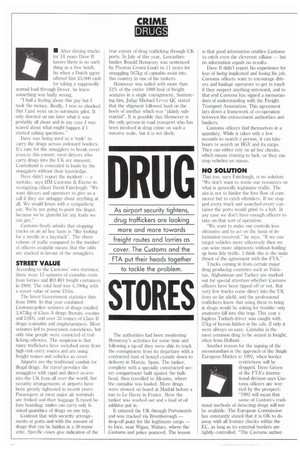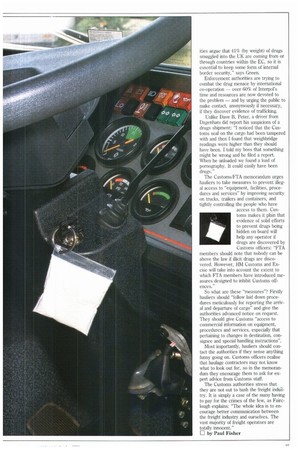STORES
Page 38

Page 39

If you've noticed an error in this article please click here to report it so we can fix it.
• After driving trucks for 14 years Dave B knows there is no such thing as a free lunch. So when a Dutch agent offered him i:3,000 cash for taking a supposedly normal load through Dover, he knew something was badly wrong.
"I had a feeling about this guy but I took the money. Really, I was so shocked that I just went on to automatic pilot. It only dawned on me later what it was probably all about and in any case I was scared about what might happen if I started asking questions."
Dave was being used as a 'mule' to carry the drugs across awkward borders. It's rare for the smugglers to break cover even to this extent; most drivers who carry drugs into the UK are innocent. Contraband is concealed in loads by the smugglers without their knowledge.
Dave didn't report the incident — a mistake, says IIM Customs & Excise investigating officer David Fairclough: "We want drivers and operators to give us a call if they are unhappy about anything at all. We would listen with a sympathetic ear. We're not going to point the finger, because we're grateful for any leads we can get."
Customs freely admits that stopping trucks on an ad hoc basis is "like looking for a needle in a haystack". The sheer volume of traffic compared to the number of officers available means that the odds are stacked in favour of the smugglers.
STREET VALUE
According to the Customs' own statistics. there were 15 seizures of cannabis resin from lorries and RU-RD freight containers in 1989. The total haul was 4,700kg with a street value of some £.15m.
The latest Government statistics date from 1988. In that year combined Customs/police seizures of drugs totalled 3,873kg of Class A drugs (heroin, cocaine and LSD), and over 33 tonnes of Class B drugs (cannabis and amphetamines). Most seizures led to possession convictions, but only nine people were convicted of trafficking offences. The suspicion is that many traffickers have switched away from high-risk entry routes and are using freight routes and vehicles as cover.
Airports are the traditional conduit for illegal drugs. Air travel provides the smugglers with rapid and direct access into the UK from all over the world, but security arrangements at airports have been greatly tightened in recent years. Passengers at most major air terminals are frisked and their baggage X-rayed before boarding: mules can carry only limited quantities of drugs on one trip.
Contrast that with security arrangements at ports and with the amount of drugs that can be hidden in a 38-tonne ante. Specific cases give indication of the true extent of drug trafficking through UK ports. In July of this year, Lancashire haulier Ronald Hennessy was sentenced by Preston Crown Court to 11 years for smuggling 567kg of cannabis resin into this country in one of his tankers.
Hennessy was nailed with more than 12% of the entire 1989 haul of freight seizures in a single consignment. Sentencing him, Judge Michael Lever QC stated that the shipment followed hard on the heels of another which was "plainly substantial". It is possible that Hennessy is the only person in road transport who has been involved in drug crime on such a massive scale, but it is not likely.
The authorities had been monitoring Hennessy's activities for some time and following a tip-off they were able to track the consignment from its departure with a contracted load of benzyl cyanide down to delivery in Murcia, Spain. The tanker, complete with a specially constructed secret compartment built against the bulkhead, then travelled to Alicante, where the cannabis was loaded. More drugs were stowed on board at Madrid before a run to Le Havre in France. Here the tanker was washed out and a load of oil additive put in.
It entered the UK through Portsmouth and was tracked via Bromborough — drop-off point for the legitimate cargo — to Ince, near Wigan, Widnes, where the Customs and police pounced. The lesson is that good information enables Customs to catch even the cleverest villains — but no information equals no results.
Dave B didn't report his experience for fear of being implicated and losing his job. Customs officers want to encourage drivers and haulage operators to get in touch if they suspect anything untoward, and to that end Customs has signed a memorandum of understanding with the Freight Transport Association. This agreement lays down a framework of co-operation between the enforcement authorities and hauliers.
Customs officers find themselves in a quandary. While it takes only a few seconds to search a person, it can take hours to search an HGV and its cargo. They can either rely on ad hoc checks, which means trusting to luck, or they can stop vehicles en masse.
NO SOLUTION
That too, says Fairclough, is no solution: "We don't want to waste our resources on what is generally legitimate traffic. The aim is not to hinder the free flow of commerce but to catch offenders. If we stopped every truck and searched every container the ports would grind to a halt In any case we don't have enough officers to take on that sort of operation.
"We want to make our controls less obtrusive and to act on the basis of information received," he says. "If we can target vehicles more effectively then we can seize more shipments without holding up bona fide traffic. I think this is the main thrust of the agreement with the FTA."
Trucks coming in from certain major drug producing countries such as Pakistan, Afghanistan and Turkey are marked out for special attention whether Customs officers have been tipped off or not. But very few trucks come direct into the UK from so far afield, and the professional traffickers know that using them to bring in drugs would be asking for trouble: only amateurs fall into this trap. This year a hapless Turkish driver was caught with 57kg of heroin hidden in his cab. If only it were always so easy. Cannabis is the most common drug to be seized in freight, often from Holland, Another reason for the signing of the memorandum is the approach of the Single European Market in 1992, when border restrictions will be dropped. Dave Green of the FTA's international division says Customs officers are worried by the prospect: "1992 will mean that some of Custom's traditional methods of detecting drugs will not be available. The European Commission has constantly stated that it is OK to do away with all frontier checks within the EC, as long as its external borders are tightly controlled. "The Customs author ities argue that 41% (by weight) of drugs smuggled into the UK are coming from or through countries within the EC, so it is essential to keep some form of internal border security," says Green.
Enforcement authorities are trying to combat the drug menace by international co-operation — over 60% of Interpol's time and resources are now devoted to the problem — and by urging the public to make contact, anonymously if necessary, if they discover evidence of trafficking.
Unlike Dave B, Peter, a driver from Dagenham did report his suspicions of a drugs shipment: "I noticed that the Customs seal on the cargo had been tampered with and then I found that weighbridge readings were higher than they should have been. I told my boss that something might be wrong and he filed a report. When he unloaded we found a load of pornography. It could easily have been drugs."
The Customs/FTA memorandum urges hauliers to take measures to prevent illegal access to "equipment, facilities, procedures and services" by improving security on trucks, trailers and containers, and tightly controlling the people who have access to them. Customs makes it plain that evidence of solid efforts to prevent drugs being hidden on board will help any operator if drugs are discovered by Customs officers: "FTA members should note that nobody can be above the law if illicit drugs are discovered. However, HM Customs and Excise will take into account the extent to which FTA members have introduced measures designed to inhibit Customs offences."
So what are these "measures"? Firstly hauliers should "follow laid down procedures meticulously for reporting the arrival and departure of cargo" and give the authorities advanced notice on request. They should give Customs "access to commercial information on equipment, procedures and services, especially that pertaining to changes in destination, consignee and special handling instructions".
Most importantly, hauliers should contact the authorities if they sense anything funny going on. Customs officers realise that haulage contractors may not know what to look out for, so in the memorandum they encourage them to ask for expert advice from Customs staff.
The Customs authorities stress that they are not out to bash the freight indatry. It is simply a case of the many having to pay for the crimes of the few, as Fairclough explains: "The whole idea is to encourage better communication between the freight industry and ourselves. The vast majority of freight operators are totally innocent."
E by Paul Fisher
















































































































